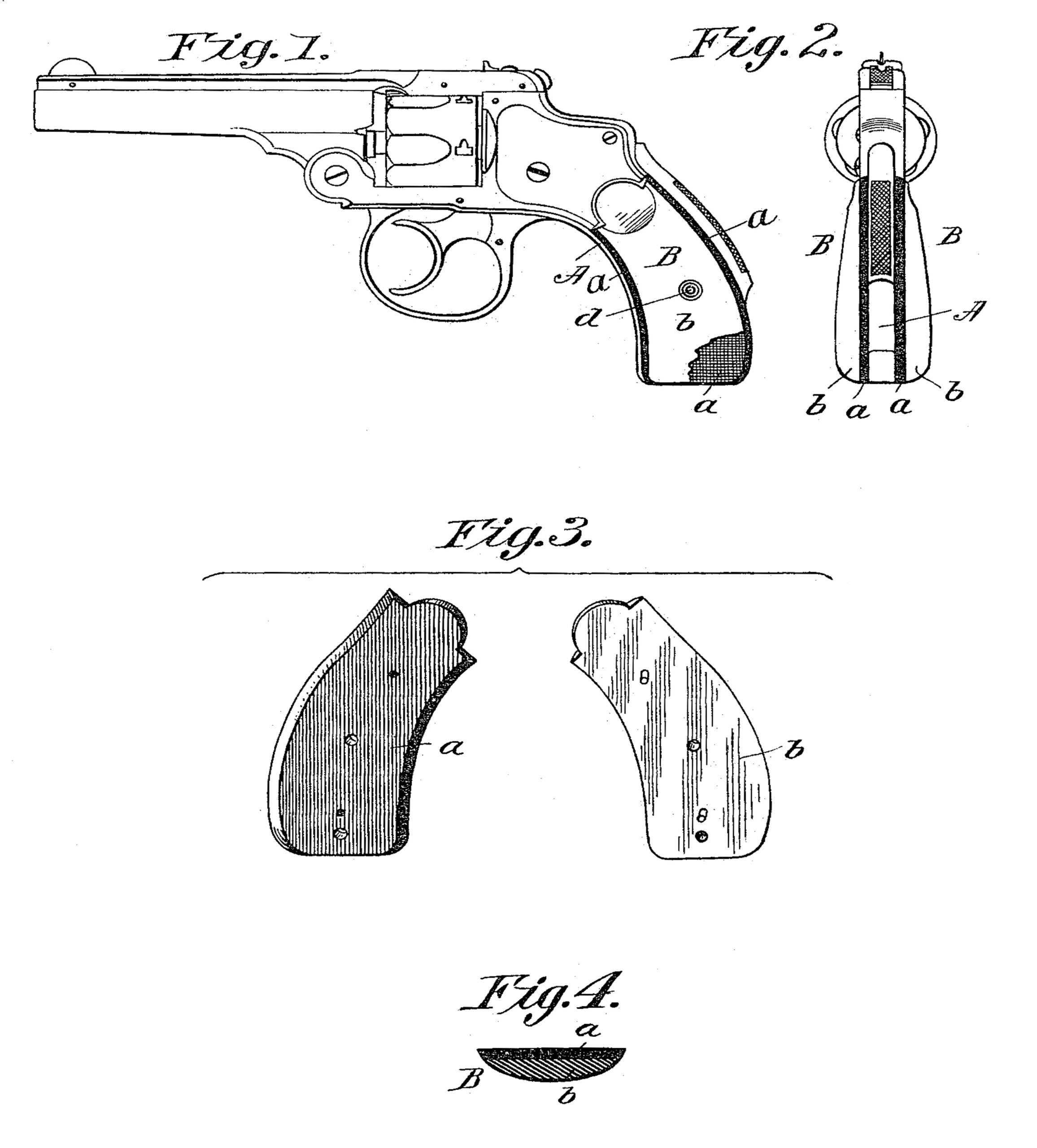US 525246
UNITED STATES PATENT OFFICE.
JOSEPH H. WESSON, OF SPRINGFIELD, MASSACHUSETTS.
HANDLE FOR FIREARMS.
SPECIFICATION forming part of Letters Patent No. 525,246, dated August 28, 1894.
Application filed June 18, 1894. Serial No. 614,420. (No model.)
To all whom it may concern:
Be it known that I, JOSEPH H. WESSON, a citizen of the United States, residing at Springfield, in the county of Hampden and State of Massachusetts, have invented new and useful Improvements in Handles for Firearms, of which the following is a specification.
This invention relates to improvements in handles for revolving fire-arms, more particularly those usually highly finished revolvers having polished mother-of-pearl cheek-pieces at the handles.
The object of this invention is accomplished by constructing the cheek-pieces, which essentially embody a thickness of pearl with a sublayer of a material which has a degree of elasticity and which is devoid of brittleness, to lie directly against the metal handle portion of the frame of the arm, and which operates to protect the more frangible outer layer of pearl by affording, in its interposition, an elastic medium to receive the shock of firing.
In the accompanying drawings, Figure 1 is a side view of a revolver with the improved handle cheek-pieces. Fig. 2 is a rear elevation of the arm. Fig. 3 is a representation in
perspective of the two layers which constitute the cheek-pieces with those sides exposed
which are imposed the one against the other. Fig. 4 is a cross sectional view of one of the
cheek-pieces.
In the drawings, A represents the handle portion of the frame of the arm which is of
metal, as usual, and B indicates the cheek-pieces, each of which, as a whole, has the usual, or any suitable contour. Each cheek-piece consists of two thicknesses, or layers, the inner one, a, of india rubber, gutta percha, or analogous material, and the outer one of mother-of-pearl. This layer, a, is vulcanized to less than the maximum degree of hardness, that is to say, it is, as compared with the pearl layer, b, yielding and elastic and devoid of the extreme frangibility of such outer layer. The two thicknesses, a and b, are joined, facewise, by a cement, or by dowels and sockets, or by both, and are held upon the handle portion of the frame, A, by the screw, d, in the usual manner; and said screw, if desired, may be relied upon to hold, or assist in holding, the layers of the cheek-piece together.
In the handle of the arm substantially as described, there is in the relation of the cheek-piece to the frame a non-metallic contact with the consequent advantage that the violence of the shock of firing is minimized in its transmission to the pearl layer, while on the other hand the layer, a, forms a semi-elastic bed for the pearl layer so that blows against the outer sides of the pearl will not be so likely to result in the fracture of the pearl as would be the case in the absence of the interposed layer, a, in which case the pearl layer would have a hard bearing against the steel or iron frame.
Having thus described my invention, what I claim, and desire to secure by Letters Patent, is—
1. A cheek piece for the handle of a fire arm which consists of an outer layer of mother of pearl and an inner layer of elastic material cemented thereto, substantially as described.
2. A cheek-piece for the handle of a fire-arm which consists of an outer layer of mother-of-pearl and an inner layer of india rubber, or analogous material, substantially as described.
JOSEPH H. WESSON.
Witnesses:
H. A. CHAPIN,
WM. S. BELLOWS.

